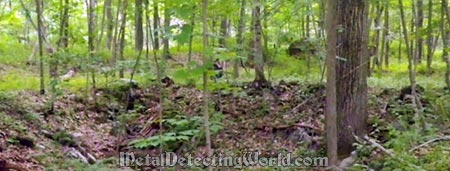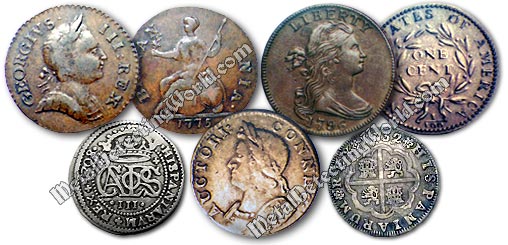Guide To Searching Former Homestead Sites Located in Remote Areas, p. 3
"Old" and "New" Cellar Holes
To describe important differences between "Old" and "New" cellar holes, I use, for simplicity, three sub-categories, in which the houses, that were built over the cellars in question, can be roughly divided:
1) pre-1800s houses that were built, inhabited, and abandoned before the 19th century;
2) houses that were built in the late-1700s - early 1800s and abandoned during the mid-1800s;
3) houses that were built during the second half of the19th century and inhabited until the early 1900s.
And if the term "Old" refers to cellar holes that are remnants of the houses of the categories 1 and 2, the term "New" refers to the cellars left over from the houses of the third category.
Obviously, the "old" cellar holes are of the greatest interest to treasure hunters due to the following reasons:
- 1. Non-ferrous junk items (except modern gun shells and brass casings discarded by deer hunters) are almost non-existent at the homestead sites of the category 1.
- 2. Ferrous and non-ferrous junk is not as abundant at the homestead sites of the category 2 as it is at the homestead sites of the category 3.
- 3. Modern junk does not exist at the homestead sites of the categories 1 and 2.
- 4. Found around "old" cellar holes, especially the pre-1800s cellars, coins and artifacts have the highest historical and monetary values.
As I mentioned above, the most desirable case for any treasure hunter would be a hunt site with a cellar hole of a house that disappeared prior to the mid-1800s! In this case, one would not be bothered with "modern" trash of all kinds, both ferrous and non-ferrous, as well as worthless coinage, buttons and buckles. One can basically metal detect in All Metal mode and dig up everything at such a site because even the rose-head square nails (hand-wrought iron nails) are collectible and can bring you $$ today.
Even if the pre-1800 property with a house still exists and in use, its front and back yards would definitely yield something worth of digging numerous pull tabs, bottle caps, foil wads, clad coins, etc. The opposite case is when one has to spend a whole day metal detecting around a "new" cellar hole while digging up tons of modern junk and get only a few "wheat" pennies in return... As always, it comes to "Research, research and research!"
As I have a big section on "How To Research" on this web site, I would not go into details on research in this article. However, it is worth of mentioning old maps that were published before the Beers Atlases in the early 1800s and show many early homesteads that vanished from the landscape before the Beer's surveyors and cartographers got there. Such rare old maps can be found in historians' manuscripts, books on local history, published diaries and genealogical papers.
If, for some reason, you have trouble finding these maps, there are two ways to locate the pre-1800 cellar holes in remote areas: you can either 1) do a lot of "foot work", or 2) talk to local hunters and ask them if they came across locations that could be classified as the "old" homestead sites. But, in any case, you need to know what signs to look for or ask the deer hunters about.
Now the question is how to tell an "old" cellar from a "new" one? Honestly, it is not easy; however, after having hit many sites of former homesteads of all three categories, one begins to see certain consistent "patterns" in appearances of the "old" cellar holes. From my own experience of searching hundreds of cellar holes in Upstate New York, I attained some "know-how" and then used it to my advantage. And now you can do it too!
Visual Characteristics of Pre-1800s Cellar Holes
A square depression in the ground or on top of a distinctive earth mound is a characteristic feature (among other features described here) of most pre-1800 cellar holes one should look for. An inexperienced scouter can easily confuse an insignificant depression that had been developed after a large tree fell and disintegrated with time for whatever is left of a true cellar. If you are uncertain about it, look around the spot and think if the surrounding landscape would allow for having not only a house but also a tool shed, a stable, a hen house and a vegetable patch at this location. Or turn your metal detector, switch to All Metal mode, and scan the area around the depression. If you hear a zillion of low-tone iron signals, you are at the right spot!

A Large Square Depression in Ground Indicates a Former Pre-1800 Cellar Hole
The reason for the majority of the pre-1800s cellar holes to be just depressions can be easily explained. Initially the cellars were inlaid with stones that were the highly-valued construction material, especially in remote and hard-to-get-to areas where such stones were not naturally available and had to be brought from somewhere else. After the house would cease to exist, for example, burnt down, its inhabitants, if they survived the fire, would not rebuild the house at the same spot. Instead, they would move to a different location and build a new house there. And they would sure take the cellar's stones with them as they could use them again for building a new root cellar. In any other case, newcomers to the area would dismantle the abandoned cellar hole, pick up the stones and move them to their home-building projects.
This practice gradually dwindled by the mid-1800s when the commercial stone quarrying began booming in Northeast Pennsylvania and Eastern New York (an example being numerous blue stone quarries in Ulster, Green and Albany counties). The road infrastructure was improved, other means of transportation (boat and rail) were established, and the flat stones for building the cellar holes, foundations, chimneys, retaining walls, property stone walls, etc. became readily available and cheap.
The easiest way to date a hunt site is to use a group of the oldest coins or artifacts belonging to the same time period and recovered at this location for reference. Such a single coin-find would not do as it most likely was lost by a boy who collected outdated coins 100 years later.
If the upper soil layer is depleted of good targets (the site might have been searched many times), dig up a few square nails, and the oldest nail will tell you the site's age. Besides, I doubt that any boy would ever collect old rusty square nails and carry them around in his pockets. (but, hey, you never know!.. Ok, he did it! :)
If you then use a secret search technique described on page 7 of this article, you might unearth any of the coins shown below (not to scale). King George coppers, Colonial coppers, early Spanish silver Reales and early US Large Cents (with a 1/100 fraction on obverse) are typical coin finds made around the pre-1800s cellar holes.

Please keep in mind that information presented here is not "carved in stone" and just a detailed reflection of what I learned from my own experience. In fact, some of the pre-1800s cellars I searched did have all their stone-inlaid walls intact. Maybe, if I hit not a few hundred but a few thousand cellar holes, I would have different statistics. But for now, this is my conclusion: pay attention to the square depressions located in the remote areas, such as deep woods and/or mountainsides, of the state parks and vast private properties, and you will increase your chances of finding coins you have dreamed about! (CONTINUED on Next Page...)